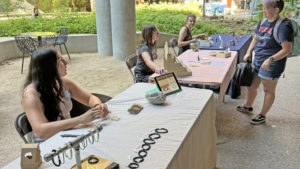
Student creators embrace new online marketplace
By: Michael Chesnick. September 26, 2024.When Reese McFarland suffered a health scare a few years ago, someone gave her a healing bracelet. Not only did it help her heal, but it also inspired her decision to study Design Arts & Practices at the University of Arizona.

“I like to be creative, and I wanted to go to college to do something creative,” McFarland said. “I had a hard time expressing what I went through, so I decided to make energy-filled beaded bracelets that are appealing to wear but also always close to your heart.”
She’s among 15 School of Art students who’ve joined Student-Made Arizona, a new online marketplace that allows them to promote and sell their products and services, such as jewelry, visual art, photography, apparel, digital art and fiber arts.

McFarland’s online shop is called “Love, Pieces.” One of her favorite bracelets is the “Lava Lotus,” she said, because lava beads are spiritually grounding and calming, while the lotus flower symbolizes health and overcoming adversity. “Each one of my bracelets have a special meaning that you can share with others or keep to yourself,” she said.
The sophomore is highlighted on the Student-Made Arizona creators’ page along with these School of Art students:
- Jordyn Auerbach (“Art by Bag”), Illustration, Design & Animation (IDA)
- Ashley Deniz (“AshDenizArt”), IDA
- Savannah Franco (“Zabana”), Studio Art minor
- Aria Green (“Varia_able”), IDA
- Jocelyn James (“artbyfair1elad1e”), Art & Visual Culture Education (AVCE)
- Hanna Lawson (“@_hippinnn”), IDA
- Sage Marshall (“Sage Malee Photo”), Photography, Video & Imaging (PVI)
- Melanie Richardson (“Lynn Galleries”), Studio Art
- Lana Rozema (“lanarozemaart”), AVCE
- Ava Jo Schuldt (“AJ Artisan”), Live Immersive Arts / Studio Art
Other School of Art students who plan to be part of Student-Made Arizona in the future are Kasey Leftwich (DAP), Natalie Benton (IDA), Xavier Urias (IDA), Vanessa Valdez (DAP) and Ava Sheppard (2D Studies).

Student-Made Arizona launched this fall, joining over a dozen universities in a Student-Made network that was co-founded in 2017 by Lindsey Reeth. Then a student at North Carolina’s Elon University, Reeth wanted to help classmates run small businesses from their dorm rooms and apartments.
Startup Wildcats, a U of A entrepreneurial group affiliated with the university’s Tech Launch Arizona, oversees the student creators and a seven-member student management team led by Daniela Johnson, a Management Information Systems master’s student.
“Since Student-Made is brand new here, it’s been incredibly rewarding to build it from the ground up and create a supportive community for student creators,” Johnson said. “As campus manager, I look forward to meeting the creators during our coffee chats and really getting to know and help them … and I hope to inspire other students to step into leadership roles.”
At Student-Made Arizona, customers can find student-created items such as phone cases, art prints, crocheted bags, keychains, customized shoes, hats and wood carvings. People also can arrange services such as photography, videography, tutoring and tech support.
Julie Barbier Bularzik, venture development education coordinator for Startup Wildcats, helped convince the university to partner with Student-Made after attending a session about the group at a conference for the Global Consortium of Entrepreneurship Centers (GCEC). Like Startup Wildcats’ mission, Student-Made provides “immersive experiences that empower every Wildcat to unlock entrepreneurial possibilities and inspire the courage to venture,” she said. In other words, life skills.

“My favorite part of Student-Made is that students get a chance to try something that can often be hard, scary or lonely in a supportive environment with a community all rooting for them to succeed,” said Barbier Bularzik, who also runs a small plant oils business, ace of cups essentials, in Tucson.
For McFarland, who grew up in Chandler, Arizona, having that support group is key — especially when it comes to gaining marketing and social media skills.
“It’s difficult to grab people’s attention and get them to like your product,” said McFarland, who is taking classes through the School of Art and the College of Architecture with a Spatial Design emphasis. She hopes to become an interior designer after graduation — but keep her bracelet business on the side.
At a recent pop-up event at the ENR2 Building on campus, McFarland shared a table area with Schuldt, a junior from the Seattle area who makes paw-print earrings that pay tribute to the Wildcats (U of A), Huskies (University of Washington) and Cougars (Washington State).
“I joined Student-Made to learn more about the business world,” Schuldt said. “I like talking to people, but I’m not so good at marketing.”
Like McFarland, Schuldt hopes to keep making art after graduation, but her career goal is to go into prop-making for film and television or live theater.

Students across campus have joined Student-Made, including Retailing and Consumer Sciences major Hannah Contardi (“engrave”) and Physiology major Elias Sitzmann (“Ari Everyday Wear”). They joined School of Art students Auerbach, Deniz, Franco, Marshall, McFarland and Schuldt at a Sept. 27 all-day pop-up event at the Campus Store across from the Student Union.
Other student creators include Nutrition and Food Studies major Tommey Jodie (“Butterflies & Azee’”), who’s also a manager; Retailing and Consumer Sciences major Liney Meis (“LimeTime Art”); and Nutritional Science major Christina Tellez (“Chrissy T. Earrings“). Other student mangers include Camryn Capuzzo, Caroline Daub, Krishna Gala, Maahi Patel and Kat Toth.
“I want departments and programs all over campus to get involved and collaborate with us in creative, mutually beneficial ways,” Barbier Bulzarik said.

And in the coming months, she hopes Student-Made creators and managers can be part of pop-up events outside the university, such as the Made in Tucson and Desert Air markets near downtown. “I’d like to have community members get involved in the mentorship of our student creators,” Barbier Bulzarik said.
Students can join Student-Made by filling out an application.
“I’d love to see more students grow their businesses,” Johnson said, “and feel empowered by the support system we’re building.”







